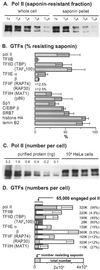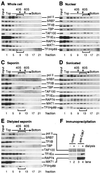Quantitation of RNA polymerase II and its transcription factors in an HeLa cell: little soluble holoenzyme but significant amounts of polymerases attached to the nuclear substructure
- PMID: 10409729
- PMCID: PMC84381
- DOI: 10.1128/MCB.19.8.5383
Quantitation of RNA polymerase II and its transcription factors in an HeLa cell: little soluble holoenzyme but significant amounts of polymerases attached to the nuclear substructure
Abstract
Various complexes that contain the core subunits of RNA polymerase II associated with different transcription factors have been isolated from eukaryotes; their precise molecular constitution depends on the purification procedure. We estimated the numbers of various components of such complexes in an HeLa cell by quantitative immunoblotting. The cells were lysed with saponin in a physiological buffer; approximately 140,000 unengaged polymerases (mainly of form IIA) were released. Only approximately 4,000 of these soluble molecules sedimented in glycerol gradients as holoenzyme-sized complexes. About 180,000 molecules of polymerases (approximately 110,000 molecules of form IIO) and 10,000 to 30,000 molecules of each of TFIIB, TFIIEalpha, TFIIEbeta, TFIIF-RAP74, TFIIF-RAP30, and TFIIH-MAT1 remained tightly associated with the nuclear substructure. Most proteins and run-on activity were retained when approximately 50% of the chromatin was detached with a nuclease, but approximately 45,000 molecules of bound TATA binding protein (TBP) were detached. Similar results were obtained after cross-linking living cells with formaldehyde. The results provide little support for the existence of a large pool of soluble holoenzyme; they are consistent with TBP-promoter complexes in nuclease-sensitive chromatin being assembled into preinitiation complexes attached to the underlying structure.
Figures






Similar articles
-
Roles for both the RAP30 and RAP74 subunits of transcription factor IIF in transcription initiation and elongation by RNA polymerase II.J Biol Chem. 1994 Oct 14;269(41):25684-91. J Biol Chem. 1994. PMID: 7929273
-
A cDNA encoding RAP74, a general initiation factor for transcription by RNA polymerase II.Nature. 1992 Jan 30;355(6359):464-7. doi: 10.1038/355464a0. Nature. 1992. PMID: 1734284
-
Topological localization of the human transcription factors IIA, IIB, TATA box-binding protein, and RNA polymerase II-associated protein 30 on a class II promoter.J Biol Chem. 1994 Aug 5;269(31):19962-7. J Biol Chem. 1994. PMID: 8051080
-
RNA polymerase II holoenzyme and transcriptional regulation.Curr Opin Cell Biol. 1997 Jun;9(3):310-9. doi: 10.1016/s0955-0674(97)80002-6. Curr Opin Cell Biol. 1997. PMID: 9159076 Review.
-
Purification and analysis of functional preinitiation complexes.Methods Enzymol. 1996;273:110-8. doi: 10.1016/s0076-6879(96)73010-0. Methods Enzymol. 1996. PMID: 8791603 Review. No abstract available.
Cited by
-
RNA polymerase II acts as an RNA-dependent RNA polymerase to extend and destabilize a non-coding RNA.EMBO J. 2013 Mar 20;32(6):781-90. doi: 10.1038/emboj.2013.18. Epub 2013 Feb 8. EMBO J. 2013. PMID: 23395899 Free PMC article.
-
In vivo dynamics of chromatin-associated complex formation in mammalian nucleotide excision repair.Proc Natl Acad Sci U S A. 2004 Nov 9;101(45):15933-7. doi: 10.1073/pnas.0403664101. Epub 2004 Nov 1. Proc Natl Acad Sci U S A. 2004. PMID: 15520397 Free PMC article.
-
Mechanobiology and the microcirculation: cellular, nuclear and fluid mechanics.Microcirculation. 2010 Apr;17(3):179-91. doi: 10.1111/j.1549-8719.2009.00016.x. Microcirculation. 2010. PMID: 20374482 Free PMC article. Review.
-
Exploiting native forces to capture chromosome conformation in mammalian cell nuclei.Mol Syst Biol. 2016 Dec 9;12(12):891. doi: 10.15252/msb.20167311. Mol Syst Biol. 2016. PMID: 27940490 Free PMC article.
-
The role of TFIIB-RNA polymerase II interaction in start site selection in yeast cells.Nucleic Acids Res. 2002 Jul 15;30(14):3078-85. doi: 10.1093/nar/gkf422. Nucleic Acids Res. 2002. PMID: 12136090 Free PMC article.
References
-
- Apone L M, Virbasius C M, Reese J C, Green M R. Yeast TAF(II)90 is required for cell-cycle progression through G2/M but not for general transcription activation. Genes Dev. 1996;10:2368–2380. - PubMed
-
- Barberis A, Pearlberg J, Simkovich N, Farrell S, Reinagel P, Bamdad C, Sigal G, Ptashne M. Contact with a component of the polymerase II holoenzyme suffices for gene activation. Cell. 1995;81:359–368. - PubMed
Publication types
MeSH terms
Substances
Grants and funding
LinkOut - more resources
Full Text Sources
Research Materials
